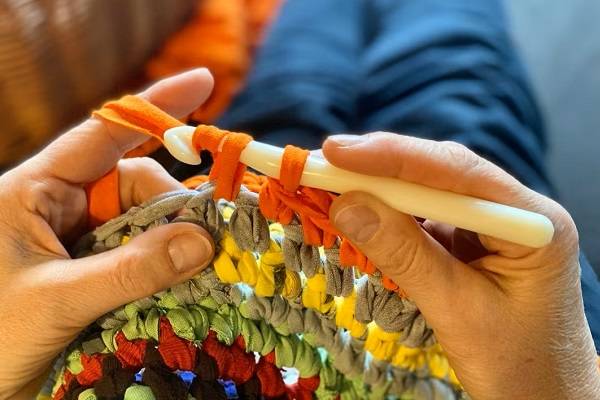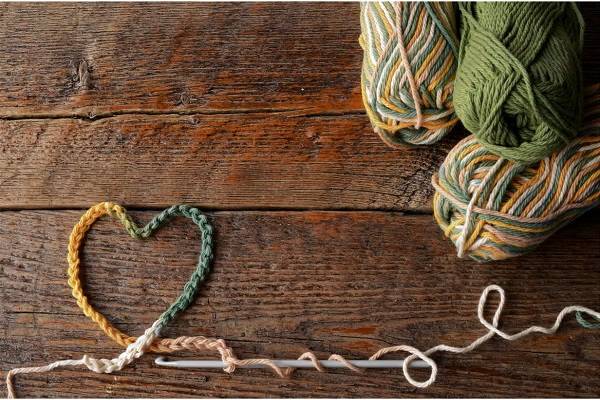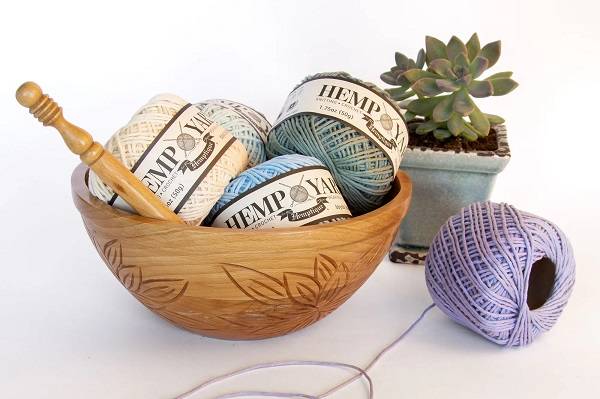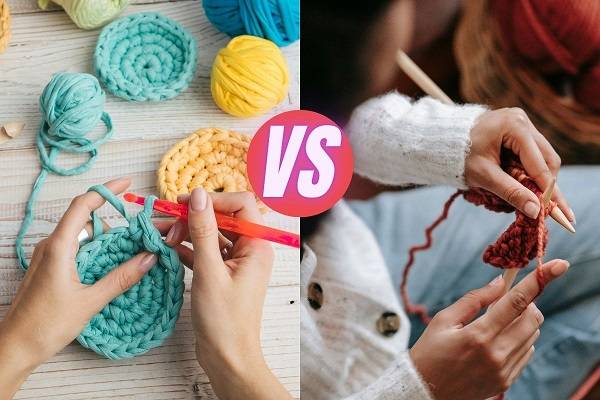A Beginners Guide to Choosing Crochet Hooks
Learn How to Find The Right Crochet Needles for Your Project. Includes Tips on Size, Types, Materials and Yarn

Innovation & Quality
Developing and supplying premium-quality, sustainably grown, consumer products
100% Natural
Organically Grown and Ethically Sourced
hemp and other natural fiber products
Shipping
We offer fast shipping
Your order out within 1-3 days
Wholesale
Visit our wholesale portal to register or login to your account
High-Quality Crochet Yarn Made Of Hemp For Eco-Conscious Crafters
Crochet Hook Anatomy

Point (head, tip) is the part at the very top of the hook, which you insert into stitches. This section can be rounded or pointy. Although the latter is easier to push through loops, if it’s too sharp it can easily split your yarn.
- Lip & mouth grab yarn and pull it through the loop, which is why they should be large enough to snitch yarn, but not too large. If they are too big, the stitches can slide off hook easily before even being worked on. The mouth section is also known as ‘the bowl’ or ‘the groove’.
- Throat is the part which guides the fiber into working area and it can be inline or tapered. Novice crafters may find inline angled throats easier to handle. We’ll talk more about the difference between the two later in the article.
- Shaft (shank) is measured in millimeters, and together with the throat and neck it holds loops that slip up and down this area. It plays a vital role in determining the size of stitches. Longer shafts are suitable for working several stitches at a time.
- Thumb rest is a wider, flattened component, sitting between right a thumb and middle finger when holding the needle. This way, you’re able to rotate the hook while crocheting. This is also a place where most manufacturers print the size.
- Handle is used to balance the needle and provides stability during crafting. It rests either inside your palm (‘knife grip’ crocheters), or on top of your finger (‘pencil grip’). They can be ergonomically designed to be easier on hands.
5 Types Of Crochet Hooks
1. Inline crochet hooks
2. Tapered hooks
3. Ergonomic hooks

4. Knook crochet hooks
5. Tunisian (Afghan) hooks
Understanding Hook Sizes
What is crochet hook size?

| US Size | Millimeters |
|---|---|
| B-1 | 2.25 mm / 2.5 mm |
| C-2 | 2.75 mm |
| D | 3.125 mm |
| D-3 | 3.25 mm |
| E-4 | 3.5 mm |
| F-5 | 3.75 mm |
| G-6 | 4 mm |
| G | 4.25 mm |
| 7 | 4.5 mm |
| H-8 | 5 mm |
| I | 5.25 mm |
| I-9 | 5.5 mm |
| J | 5.75 mm |
| J-10 | 6 mm |
| K-10 | 6.5 mm / 7 mm |
| L-11 | 8 mm |
| M/N-13 | 9 mm |
| N/P-15 | 10 mm |
| P-16 | 11.5 mm / 12 mm |
| P/Q | 15 mm |
| Q | 16 mm |
| S | 19 mm |
| T/U/X | 25 mm |
| T/X | 30 mm |
Steel crochet hooks sizing
| US Label | Metric |
|---|---|
| 00 | 2.7 mm |
| 0 | 2.55 mm |
| 1 | 2.35 mm |
| 2 | 2.25 mm |
| 3 | 2.10 mm |
| 4 | 2 mm |
| 5 | 1.90 mm |
| 6 | 1.80 mm |
Tunisian hook sizes
Most commonly used sizes
Hooks for worsted weight yarn – It is mostly recommended to use H-8 (5 mm metric size) for worsted weight yarn.
Hooks for fingering weight yarn - It is best to use D-3 (3.25 mm) size hook with fingering weight yarn, which is smaller than the worsted weight one.
Hooks for jumbo yarn – Choose S (S-35, 19 mm) needle to craft bulkier items from jumbo, roving yarn or rope.
Hooks for beginners – In the beginning of your journey, select sizes ranging from E to J (3.5 mm to 6 mm). They will be easier to manipulate until you improve your skills enough to move to other sizes.
Materials
- Bamboo feels warm in the hand, it’s not expensive, it’s eco-friendly, and easily accessible, making it a perfect choice for beginners. Plus, it provides a good grip and allows for better control of slippery fibers like rayon, silk, or bamboo. Over time, they become smoother and improve their performance. The only downside is that sometimes the tip is too sharp and may need sanding before first use.
- Acrylic (plastic) is the best choice for beginners. It’s sturdy, smooth, lightweight, and low priced. It is available in many bright colors making them fun for kids who want to learn how to crochet. They have moderate grip but unfortunately are not the best solution for the environment, so opt for other materials if you can.
- Metal (aluminum) hooks are durable and strong but allow for faster crocheting because they have less grip. It’s especially great for use with fiber that tend to stick to themselves, like wool, mohair, and alpaca. The disadvantage is that it’s heavy, can be cold, and may cause fatigue in the hands.
- Wood allows for comfortable grip, it’s warm, and lightweight. As an eco-friendly option, it can be pricier than other options.
- Steel is the strongest material and usually manufactured in the smallest sizes (for lace and doily projects). It is also great for incorporating beads into the fabric.
Hook & Yarn Pairings
Yarn label – Every yarn label contains guidelines and information on what needle size to use with that specific yarn. Most manufacturers provide both US and metric sizes, so make sure you’re looking at the correct one. The label also has information on yarn’s composition, weight and its category.
Pattern information – At the beginning of your pattern you will find information on the adequate size to use. For instance, light and airy scarves call for larger sizes, while amigurumi figures or 3D textured products require you to use smaller sizes.
Stitch tension – Use smaller size for tighter stitches and larger size for loose stitching techniques.
| Yarn weight | Suggested US Size | Metric sizes |
|---|---|---|
| 0, lace, thread | Steel #1, steel #2, B-1 | 2.35 mm, 2.25 mm, 2.50 mm |
| 1, super fine, finger or sock weight | C-2, D-3 | 2.75 mm, 3.25 mm |
| 2, fine, sport, baby weight | E-4, F-5 | 3.5 mm, 3.75 mm |
| 3, light, DK, light worsted | G-6, 7, H-8 | 4 mm, 4.5 mm, 5 mm |
| 4, medium, worsted, Afghan | I-9, J-10 | 5.5 mm, 6 mm |
| 5, bulky, chunky | L-11, M, N | 8 mm, 9 mm |
| 6, super bulky, roving super chunky weight | N/P-15 | 10 mm |
| 7, jumbo | P/Q, Q | 15 mm, 15.75 mm, 16 mm |
Recommended Product
- Weight: heavy worsted
- Material: Cotton 65%, Hemp 35%
- Size: 1.75 oz (50g)
- Crochet hook size: I-9 (5.5mm)
- Colors: Mint, Periwinkle, Sky Blue, Natural, Dusty Pink & Moss Green
Tips For Selecting Crochet Hooks
Comfortability - Test out different materials to find the one that suits you best.
- Pattern recommendation – Patterns usually contain advice on preferred hook size.
- Yarn & hook pairing - Don’t use a tiny hook with bulky yarn. If you’re switching the needle, do the same with yarn, make sure their weight/size are matching.








